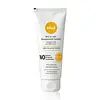What's inside
What's inside
 Key Ingredients
Key Ingredients

 Benefits
Benefits

 Concerns
Concerns

No concerns
 Ingredients Side-by-side
Ingredients Side-by-side

Water
Skin ConditioningOryza Sativa Extract
AbsorbentPaba
Benzophenone-3
UV AbsorberBenzophenone-4
UV AbsorberMethylene Bis-Benzotriazolyl Tetramethylbutylphenol
UV FilterHydroxyapatite
AbrasiveEthylhexyl Methoxycinnamate
UV AbsorberButyl Methoxydibenzoylmethane
UV AbsorberPolysorbate 20
EmulsifyingAloe Barbadensis Leaf Extract
EmollientDipotassium Glycyrrhizate
HumectantAscorbic Acid
AntioxidantTerephthalylidene Dicamphor Sulfonic Acid
UV AbsorberHyaluronic Acid
HumectantTocopherol
AntioxidantSilica
AbrasiveHibiscus Hamabo Extract
HumectantButylene Glycol
HumectantSodium Benzoate
MaskingZinc Oxide
Cosmetic ColorantTitanium Dioxide
Cosmetic ColorantMorus Alba Extract
AstringentPhospholipids
Skin ConditioningPhenoxyethanol
PreservativeWater, Oryza Sativa Extract, Paba, Benzophenone-3, Benzophenone-4, Methylene Bis-Benzotriazolyl Tetramethylbutylphenol, Hydroxyapatite, Ethylhexyl Methoxycinnamate, Butyl Methoxydibenzoylmethane, Polysorbate 20, Aloe Barbadensis Leaf Extract, Dipotassium Glycyrrhizate, Ascorbic Acid, Terephthalylidene Dicamphor Sulfonic Acid, Hyaluronic Acid, Tocopherol, Silica, Hibiscus Hamabo Extract, Butylene Glycol, Sodium Benzoate, Zinc Oxide, Titanium Dioxide, Morus Alba Extract, Phospholipids, Phenoxyethanol
Ingredients Explained
These ingredients are found in both products.
Ingredients higher up in an ingredient list are typically present in a larger amount.
Methylene Bis-Benzotriazolyl Tetramethylbutylphenol (Tinosorb M) is a hybrid and broad-spectrum UV ingredient. It is both a UV absorber and filter.
UV absorbers are an agent that absorbs UV rays. They protect your skin by using chemical reactions to convert UV rays into heat and energy. UV filters physically reduce the amount of UV rays from reaching your skin.
Tinosorb M covers a range of 280-400 nm and is photostable. This ingredient is neither oil or water soluble.
Tinosorb M is not available in the US. However, it is available in the EU and Asia.
It's sister, Tinosorb S, is set to be approved in the US by late 2025 (fingers crossed!).
Learn more about Methylene Bis-Benzotriazolyl TetramethylbutylphenolSodium Benzoate is a preservative. It's used in both cosmetic and food products to inhibit the growth of mold and bacteria. It is typically produced synthetically.
Both the US FDA and EU Health Committee have approved the use of sodium benzoate. In the US, levels of 0.1% (of the total product) are allowed.
Sodium benzoate works as a preservative by inhibiting the growth of bacteria inside of cells. It prevents the cell from fermenting a type of sugar using an enzyme called phosphofructokinase.
It is the salt of benzoic acid. Foods containing sodium benzoate include soda, salad dressings, condiments, fruit juices, wines, and snack foods.
Studies for using ascorbic acid and sodium benzoate in cosmetics are lacking, especially in skincare routines with multiple steps.
We always recommend speaking with a professional, such as a dermatologist, if you have any concerns.
Learn more about Sodium BenzoateWater. It's the most common cosmetic ingredient of all. You'll usually see it at the top of ingredient lists, meaning that it makes up the largest part of the product.
So why is it so popular? Water most often acts as a solvent - this means that it helps dissolve other ingredients into the formulation.
You'll also recognize water as that liquid we all need to stay alive. If you see this, drink a glass of water. Stay hydrated!
Learn more about Water